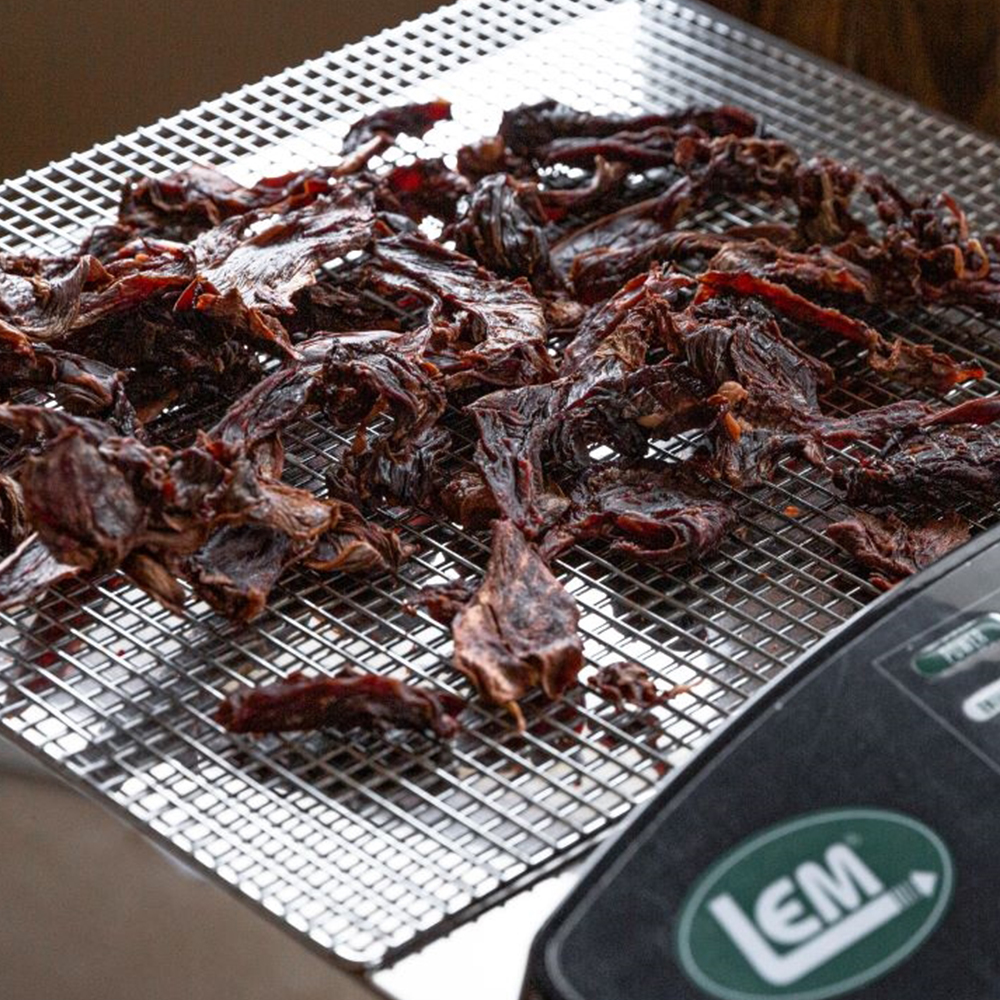

For those hunters who believe nothing should go to waste, and that our best four-legged friends, who never leave our side at the skinning pole, deserve to enjoy the fruits of our labor, there’s great news: Making dog treats using your dehydrator is incredibly easy and makes use of protein you might otherwise throw away, including silver skin, fascia, and even fat trimmings.
Tongues lolling about, our dogs’ never-quitting smile is their way of asking: “So, what’s in this for me?” Some of us may reserve a slice or two of fresh, medium-rare backstrap for our pups, while stricter (read: “crueler”) hunters would never dare. But while there are many options for turning deer scraps into dog treats, it’s important to follow some important steps.
Roasted or cooked bones may crack upon chewing and those splintered bits of bone, if angle just right during digestion, run the risk of puncturing intestines or stomach. I, along with most vets, don’t recommend it.
However, I have on occasion given my dog a raw bone, though I put his e-collar on him ahead of handing off. It’s common for dogs—even the sweet ones—to get really grump the moment you try to take a bone from them, so I might need to give him a little love tap on the remote to remind him who’s making the decisions around here.
I will make sure to watch and listen and the moment I hear the bone crack, I take it back.
What about antlers (technically bone)? For sheds or potentially the fresh horns off a buck (perhaps he looked bigger through the scope?), a lot of vets also recommend not giving to dogs. Yes, I know there are elk antlers sold as chews in pet stores, but I’ve interviewed bird-dog vets who have told me hunters giving their dogs antlers, resulting in chipped teeth, is what is putting their grandkids through college.
The deer itself is tasty enough for a dog—no need to add any unnecessary spices or sodium to their diet. In regard to curing, yes, there is the argument doing would preserve the treats for longer, but as you continue to read, you will find out there will be plenty of opportunities to make dog treats.
For any of these treats, if dehydrated long enough, they will keep and remain fresh if stored in the fridge for easily 2 weeks. For many of these treats, a good seal (especially with a chamber vac), will allow for cupboard storage where they’ll maintain a shelf life of a month, potentially longer.
Trimmed silver skin, fascia, and sometimes fat
Ruby-red venison is always the goal when prepping to cook for humans. For dogs, all those little bits and slivers of silver skin—the stuff that makes most people wince—is something incredibly special.
Organs
When properly cleaned, these wobbly bits that might normally get left in the gut pile make for great snacks for our best canine friends. As a general rule, I pack a clean tarp and a small cooler for when it’s time to dress a deer. I don’t want to get grass, leaves, or dirt on organs, as I save as much as I can. Whenever possible, I try to salvage the heart, liver, and kidneys, then sometimes the spleen and the trachea, which I may pull with butchering the neck.
Ahead of freezing these organs, I will often create a saltwater brine in which to soak the organs as a way to draw out residual blood. After doing so, it’s important to thoroughly rinse of the brine in cold water ahead of freezing.
A NOTE ON TATTERED ORGANS: I believe these are safe to clean and use for dog treats IF ruptured with a broadhead or non-lead-core-based bullet. The concept of lead fragments in meat is a concern, as ingesting even small amounts of lead can result in serious health issues.
Dogs prefer dry treats, and dry treats keep longer. I suggest a minimum of 12 hours at 155 F. What this means: You can trim, clean—whatever is necessary—then set the bits on a try, kick on your dehydrator and leave running overnight. Shortly after you wake up in the morning, the treats are ready for your pup.
If dealing with silver skin, fascia, or bits of fat in or on meat, I suggest going as long as 16 hours at 155 F. Anything that isn’t lean meat is prone to oxidization and may spoil sooner, especially if not very dry.
For organs like spleen and liver, which tend to retain moisture longer, you may want to go 16-18 hours at 155 F.
With all meat, make sure nothing is thicker than half an inch. Remember, also, brittle is better than slightly moist, as slightly moist will spoil sooner. We don’t want to serve our dogs moldy snacks.
Allow the dehydrated treats to cool off for a couple hours then place as tight of seal as possible on them. LEM chamber vacuum sealers are great for this. However, because of the tight seal, sometimes dry jerky, with its jagged edges, and can puncture the bag. If this happens, the seal will be broken, so you will need to re-seal. However, in full transparency, I’ve yet to have this happen with LEM bags, only off-brand chamber-vac bags. Nevertheless, ensure a tight seal, for starters.
For very lean, dry treats—no fat or fascia present, for example—you can store these in the cupboard for a month or two. Always check for mold if not served within a week.
For organ treats, or those that may contain a bit of silver skin, fascia, or fat—might be best to store these in the fridge, where they’ll stay fresh for at least a couple weeks.
Once you break open the seal and if you don’t reseal, you should store your dog treats in the fridge.
Freezing tightly sealed dog treats will stay preserved indefinitely.
Reach out to me on Instagram (@WildGameJack) with any questions or comments.